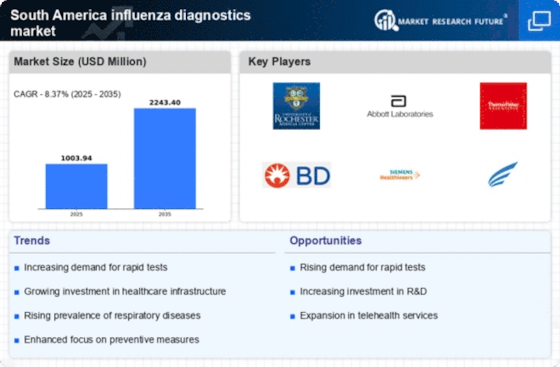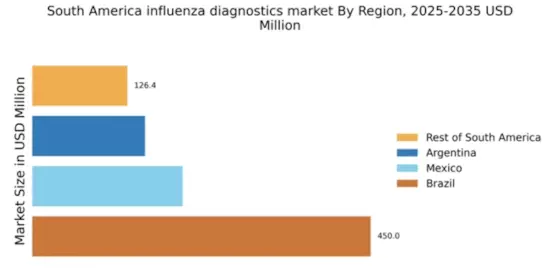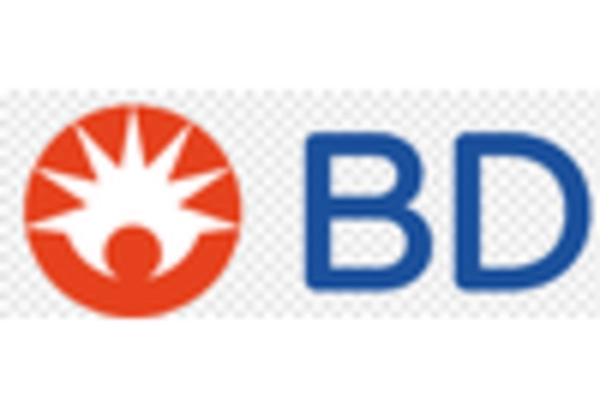The influenza diagnostics market in South America is characterized by a competitive landscape that is increasingly shaped by innovation, strategic partnerships, and regional expansion. Key players such as Roche (CH), Abbott (US), and Thermo Fisher Scientific (US) are actively pursuing strategies that enhance their market presence and operational efficiency. Roche (CH) focuses on developing advanced diagnostic solutions, leveraging its strong R&D capabilities to introduce novel products that cater to the evolving needs of healthcare providers. Abbott (US), on the other hand, emphasizes strategic partnerships with local healthcare institutions to enhance its distribution network and improve access to its diagnostic tools. Meanwhile, Thermo Fisher Scientific (US) is investing in digital transformation initiatives, aiming to streamline operations and enhance customer engagement through technology-driven solutions. Collectively, these strategies contribute to a dynamic competitive environment, where innovation and collaboration are paramount.
In terms of business tactics, companies are increasingly localizing manufacturing and optimizing supply chains to respond swiftly to market demands. The competitive structure of the influenza diagnostics market appears moderately fragmented, with several key players exerting influence over various segments. This fragmentation allows for a diverse range of products and services, catering to different customer needs while fostering healthy competition among established and emerging players.
In October 2025, Roche (CH) announced the launch of a new rapid influenza diagnostic test that significantly reduces the time required for results, enhancing patient management in clinical settings. This strategic move is likely to strengthen Roche's position in the market by addressing the urgent need for timely diagnostics, particularly in regions with limited access to healthcare resources. The introduction of this product aligns with the growing demand for rapid testing solutions, potentially increasing Roche's market share in South America.
In September 2025, Abbott (US) expanded its collaboration with local health authorities in Brazil to improve the distribution of its influenza diagnostic kits. This initiative not only enhances Abbott's market penetration but also demonstrates its commitment to addressing public health challenges in the region. By aligning its operations with local health priorities, Abbott is likely to foster goodwill and strengthen its brand reputation among healthcare providers and patients alike.
In August 2025, Thermo Fisher Scientific (US) unveiled a new cloud-based platform designed to integrate data from various diagnostic devices, including influenza tests. This platform aims to facilitate real-time data sharing among healthcare professionals, thereby improving decision-making processes. The strategic importance of this development lies in its potential to enhance the overall efficiency of influenza diagnostics, positioning Thermo Fisher as a leader in digital health solutions within the market.
As of November 2025, current trends in the influenza diagnostics market are increasingly defined by digitalization, sustainability, and the integration of artificial intelligence (AI) into diagnostic processes. Strategic alliances among key players are shaping the landscape, enabling companies to leverage each other's strengths and resources. Looking ahead, competitive differentiation is expected to evolve, with a notable shift from price-based competition to a focus on innovation, technological advancements, and supply chain reliability. This transition underscores the importance of developing robust, efficient, and sustainable diagnostic solutions that meet the demands of a rapidly changing healthcare environment.


















Leave a Comment